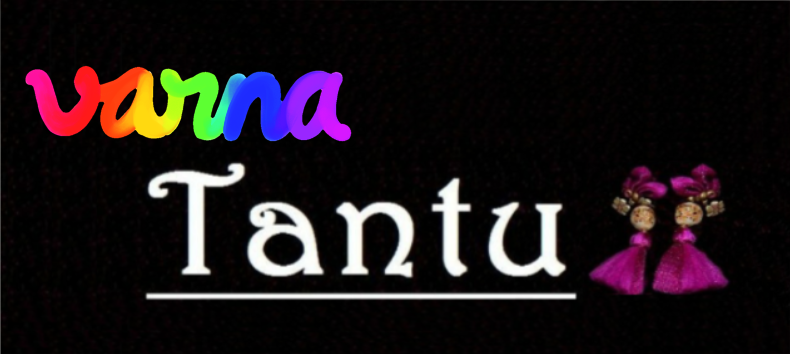A collection of photos of traditional textiles I sighted at Khadi Utsav 2017 and Khadi Utsav 2018 (2nd January 2018 – 31st January 2018). Can you identify them? Note the points, if they are new to you.

Our ancestors gave Tahkli – a hand spinning tool (based on which modern spinning machines work) and Charaka to the world of textiles. So, it is not a wonder that Bharat (India) is the birthplace of hundreds of unique textiles and textile arts. It is great to know them, buy them and be proud of.
Kasuti, Ilkal Textiles, Kaudi Work, Lambani Embroidery from Karnataka
Kasuti embroidery is counted thread work known for its identical two way (reversible) nature. The short lines move in vertical, horizontal or diagonal ways only to make a variety of motifs (birds, animals, plants, etc.). There are no curved or free hand designs.
Ilkal saris are woven by weavers of Ilkal town of Bagalkot district. Mainly the sari has solid or checks body. Pallu will be with unique stripes.
Kaudi work is a beautiful combination of patch work and embroidery. Lambani or Banjara embroidery and kaudi works can be identified by the multiple series of couching embroidery stitches. In simple words, the embroidery consists of rows of running stitches and wrapping of decorative threads. Mirror works are a part of Lambani embroidery.
Eco friendly colours
Originally, all the traditional textiles were coloured with natural dyes. Today, some textiles like Kalamkari of Andhra Pradesh, Ikkat are known for retaining natural colouring methods. If you see any Khadi product with colours having autumn colour scheme (not bright like summer colours), you can be sure that they are with natural colours.
Bandhni, Shisha Work and Kutch work of Gujarat
Bright colours, mirrors, bandhnis (tied and dyed spots), playful motifs all confirm that the textiles are from Gujarat. Kutch embroidery looks similar to Kasuti of Karnataka. But, you will notice couching (thread wraps) in addition, to make geometrical motifs.
Ikkat of Odisha
Warp and weft threads are tie-dyed separately creating multi-coloured patterns. Then they are woven together to create unique ikkat textiles superimposing the warp and weft tie-dyed sections. Designs look as if the colours bleeded irregularly out of each thread and that gives its original look. Usually, the colours are natural.
Kantha of Bengal

Kantha Embroidery of Bengal 2018
Bengal is known for its muslins ( the finest cotton fabrics). I couldn’t capture them. I have a picture of Kantha embroidery from Bengal. Floral motifs, lots of running stitches to define structures, and colours are the specialty of Kantha. Kantha looks similar to Chikankari at first glance.
Embroidery from North-east India
I saw tribal embroidery works from North-east. I could notice large-regular petalled flower designs and geometrical designs with mirror works spread lightly all over. Mostly North-east textiles are with woven patterns, I didn’t see them in the event. North-east is famous for its muga silk, eri silk, mekhala (two piece sari) but they are all established as brands and I didn’t find them in Khadi Utsav.
Chikankari of Uttar Pradesh
Chikankari is known for its see through ‘Shadow work’ on muslins or even on chiffons. If you see outlined designs with shadow filling made using white thread, it is surely Chikankari work. I didn’t see Chikankari in its true form in Khadi Utsav but had seen in Bharatiya Craft Mela.
Phulkari of Punjab
As it’s name suggests, it is a colourful flower filled textiles. Satin and satin-like filling stitches are mainly used. I was happy to see machine embroidered Phulkari, I think it is a healthy adaptation.
Kashida of Kashmiri
Kashmiri embroidery is with flower motifs made of chain stitches. They are brightly coloured. I saw woolen saris too.
P.S.:
Luckily, our rich textile tradition has survived against cultural globalisation. And cottage industries reach we common people through Khadi/textile exhibitions. Though some traditional textiles like Mysore silk, Kachipuram silk, Dharmavaram silk, Paithni, Banaras silk, Muga silk, Tassar silk, Pashmina shawls, etc have become world famous, not every textile has got the opportunity. Thanks to our central Government for its India Handloom Brand initiative in 2015 and for its recent announcement of 0% GST for handloom sector in support of Khadi industry. We can hope Khadi products to be more competitive in future.
To ‘the tradition carriers’, the makers: People can buy more textiles if you provide small products like kerchiefs, pouches, clutches, handbags, dupattas, etc. (Thus, everyone’s dream to own Khadi can come true too.) Some are doing it already.







India has such amazing variety of textiles. Very colorful captures. Good educational post.
Thank you for your kind words, Indrani 🙂 True, our tradition is enriched with mind blowing textile varieties! These are from the little I managed to click from exhibited collection. Most of the photos are unedited.